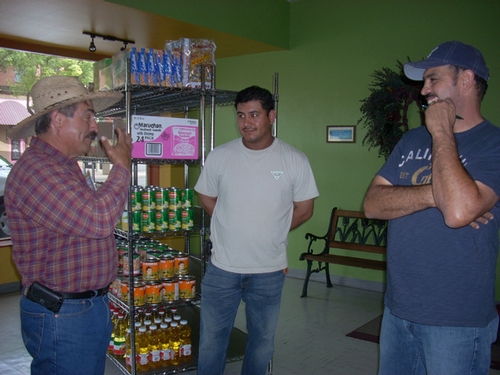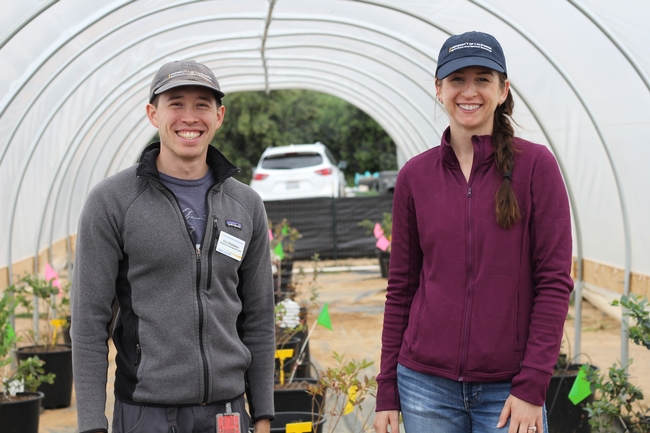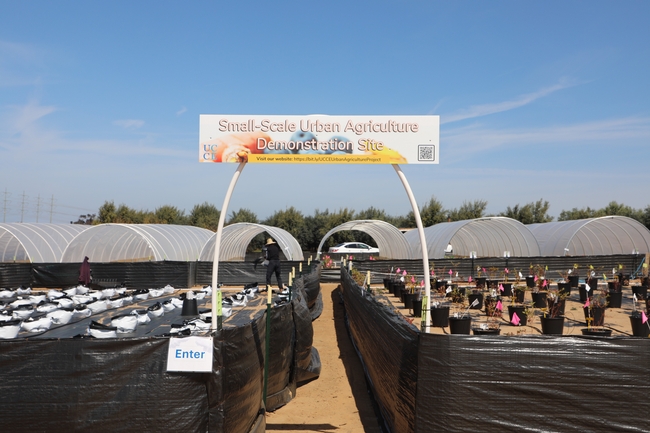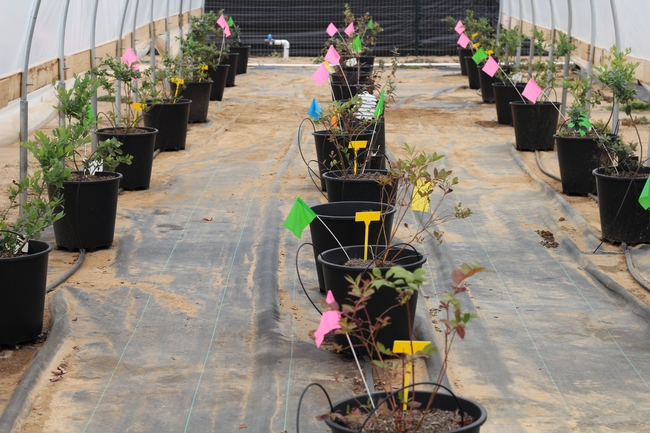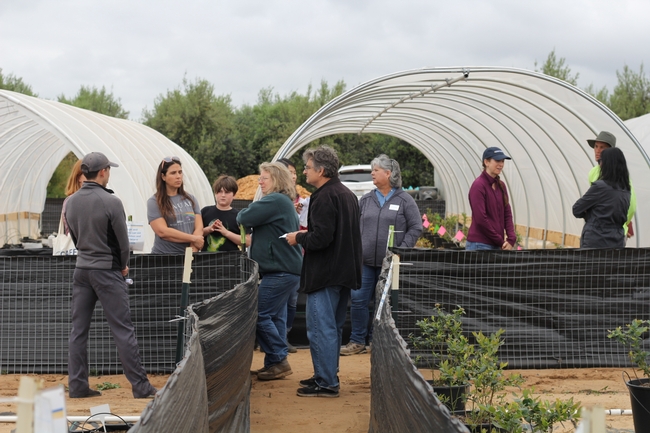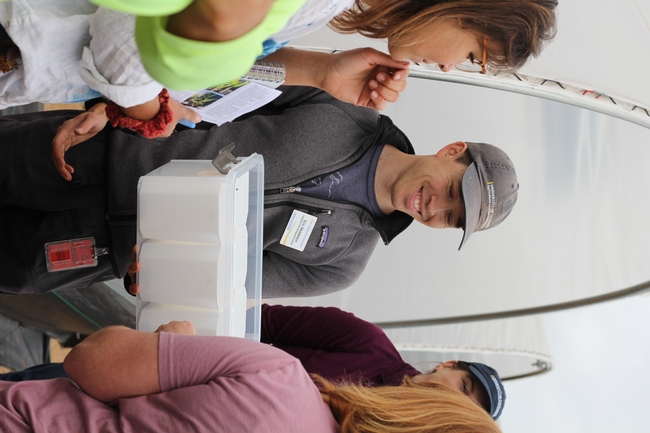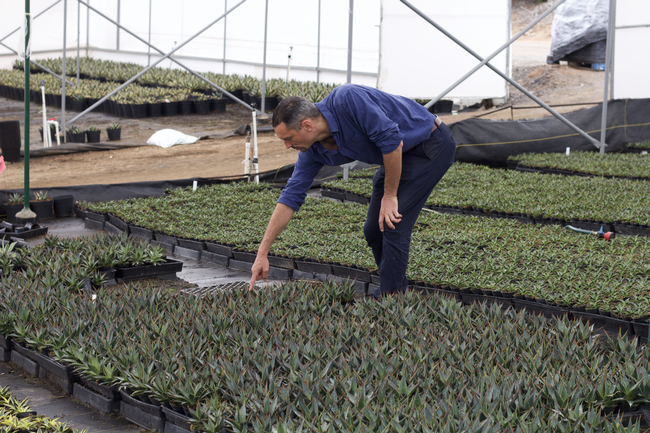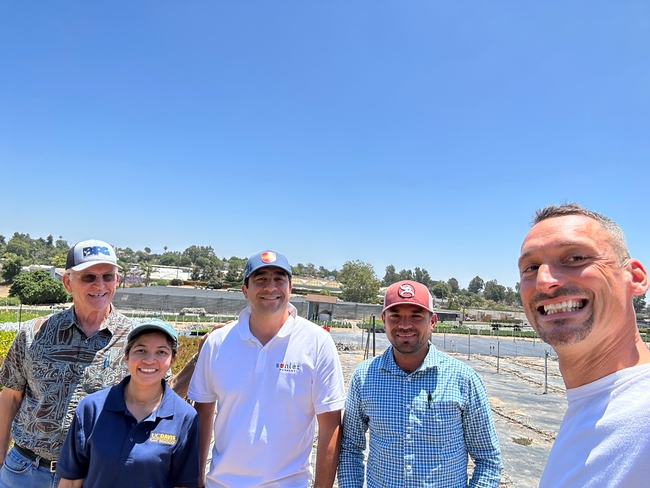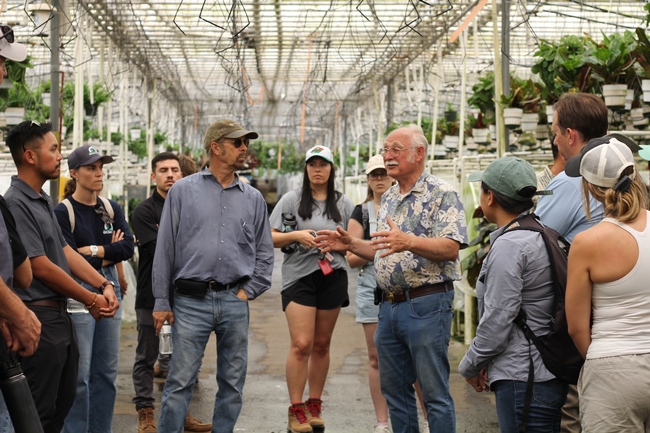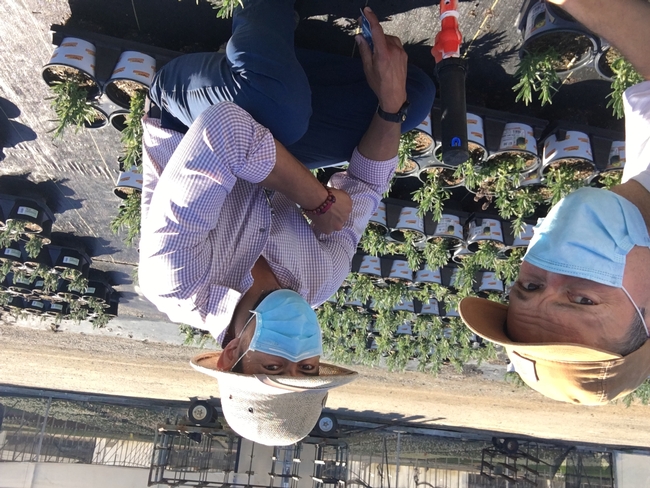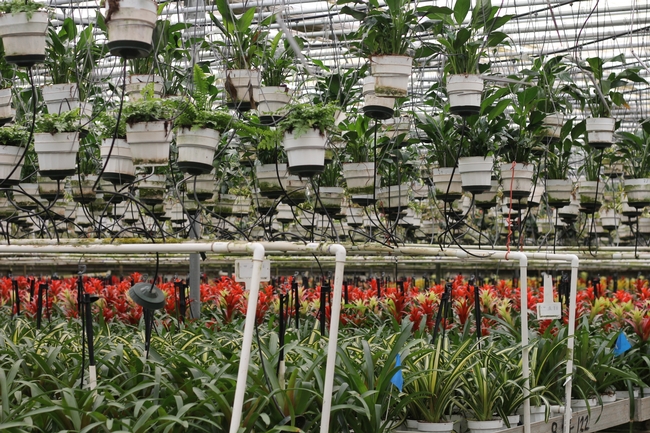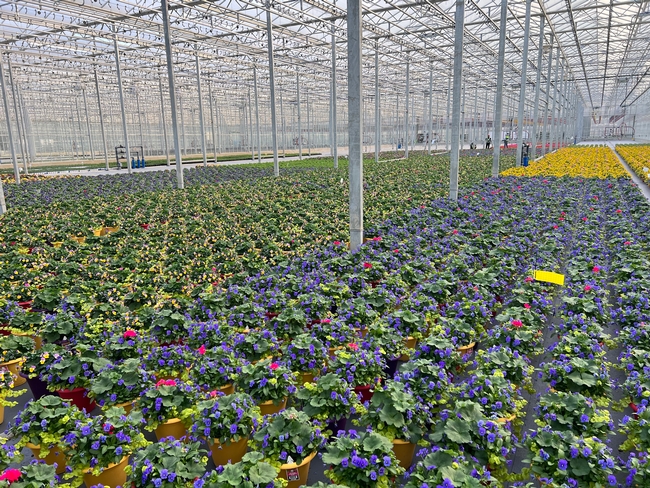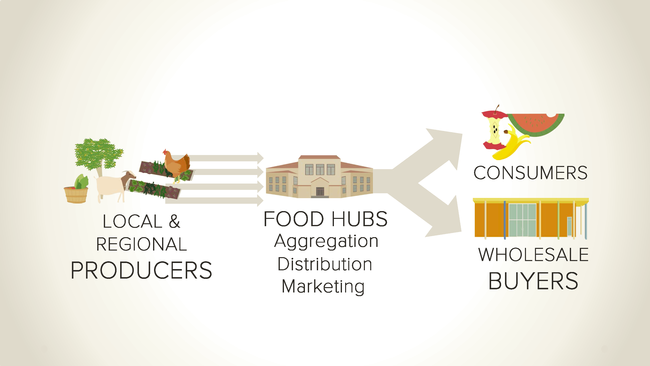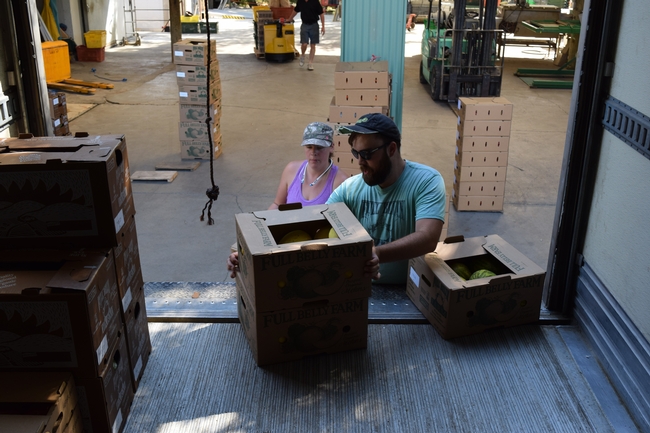Posts Tagged: growers
Could empty lots be growing food, economic opportunity?
UCCE scientists study feasibility of specialty crops for small urban growers
The vacant lots around your neighborhood could be growing fruits and vegetables and making local produce more accessible – while reducing energy needed to transport and distribute the food. Could turning those empty lots into small farms also become opportunities for economic development?
To answer this question, a team of researchers from University of California Cooperative Extension in San Diego County are investigating the economic feasibility of growing high-value specialty crops in urban settings like vacant lots. The project – led by Eric Middleton, UCCE integrated pest management advisor for San Diego, Orange and Los Angeles counties – is currently in progress at The Flower Fields in Carlsbad, a seasonal attraction for locals and tourists.
Tucked away in the back of the field is the Small-Scale Urban Ag Demonstration Site where Middleton and his team established a small farm on approximately 17,000 square feet, starting fall 2023. Funded by the U.S. Department of Agriculture National Institute of Food and Agriculture, the farm is designed to evaluate containerized production both outdoors and under high tunnels.
Growers don't necessarily need land, just space
High tunnels, also referred to as hoop houses, are semi-permanent structures that act similarly to greenhouses in providing a controlled environment. For the experiment, Middleton will compare cost, effort and durability of two types of high tunnels: one made of steel and the other out of PVC pipes.
“We want to give interested growers information on as many options as we can,” said Middleton, who explained that the project is motivated by the challenges of urban settings, including limited space and lack of arable land.
In the trial, they are growing turmeric, ginger and blueberries. The high-value crops were selected because of their potential to earn a profit. Data evaluating plant variety, soil mix, fertilizer, growth performance, yield and pest and disease pressures will be collected and reported when the project concludes in 2026.
As the crops develop in containers – blueberries in pots and turmeric and ginger in grow bags – Middleton pointed out the mobility aspect of the study, noting that growers don't necessarily need land, just space.
Whether it's a backyard or a rooftop, containerized production means easier transport, especially since vacant land doesn't always remain vacant forever and urban lots may often need soil remediation. Growing in containers solves the anticipated problem of having to relocate.
Where to set up shop in San Diego County
Jan Gonzales, project coordinator and community education supervisor for UCCE San Diego County, is leading the effort to identify available urban land in San Diego County as well as the policies and procedures for growers to access these spaces.
Gonzales is collaborating with community members who are working on similar projects to identify space for prospective growers.
“This has been done before for different objectives and for specific areas in the region, but the information was either project-specific and not publicly available, or not easy to find,” Gonzales said.
Having spoken with people associated with previous or ongoing agricultural land mapping projects, Gonzales has agreed to coordinate and facilitate an advisory work group to discuss areas of potential collaboration and develop project efficiencies. She anticipates holding the first group meeting before the end of the summer.
A production guide to help community members re-create the project
The ideal audience for a study like this is anyone who wants to grow specialty crops, according to Lindsey Pedroncelli, interim director of UC South Coast Research and Extension Center in Irvine, who worked on the project alongside Middleton when she was a staff research associate with UCCE San Diego.
“If you're a new grower or a grower who wants to diversify your crop production, what we're learning here can be applied to you,” said Pedroncelli.
Pedroncelli has been instrumental in bringing the experiment to life and documenting its step-by-step workflow thus far. The production guide, which is being created as the study unfolds, will include instructions detailing how to replicate the experiment from the ground up. Currently, it contains information on how to design your farm, the materials to buy, building structures, irrigation setup and crop management.
The most intriguing open question, whether the operation is profitable, is the driving force behind the production guide and will certainly be addressed, Pedroncelli said.
Book a tour and visit the farm
When visiting the farm, you'll encounter three varieties of blueberries: Star, Snowchaser and Misty. Snowchaser has been a top producer since it was planted in January, but the variety is known to be an early season producer.
Using only one variety of each, the turmeric and ginger were planted in late March-early April. With some unanticipated cold weather in San Diego County, both crops struggled when transitioning out of dormancy, leading to very slow progress, which the team is still navigating today.
Visually, Middleton and his team have noticed differences between the crops growing under the high tunnels versus those grown outdoors, although the data has not been analyzed to confirm or explain notable differences.
Attempting to demonstrate how to profitably grow high-value crops in urban settings using limited space and resources, Pedroncelli said she hopes this study will also encourage people to grow culturally significant crops for their communities.
To tour the Small-Scale Urban Ag Demonstration Site at The Flower Fields in Carlsbad, email Eric Middleton at egmiddleton@ucanr.edu with "Urban Agriculture Demonstration Site Tour" in the subject line.
To learn more about the project and its progress, visit https://ucanr.edu/sites/socalIPM/Small_Scale_Urban_Agriculture_Project_/.
UCCE San Diego advisor educates growers on complex water regulations
‘Ag Order' for San Diego County expected to be enforced by end of 2023
Generally known for its steady warmth and picturesque beaches, San Diego County is also home to nearly 5,000 small farms and is an economic hotspot for nurseries and floriculture. But the great diversity of ornamental crops that dominate the growing region and complexity of regulations make compliance challenging for growers, some of whom grow over 400 crop varieties.
“The regulatory environment for the growers is still complicated and overwhelming because, along with the Regional Water Board, growers are regulated by the County of San Diego,” said Gerardo “Gerry” Spinelli, University of California Cooperative Extension production horticulture advisor for San Diego County.
To help growers with compliance, Spinelli is prioritizing education and expanding growers' knowledge. By partnering with organizations such as the Farm Bureau of San Diego County and the San Diego Region Irrigated Lands Group, Spinelli works to reach more than 1,200 growers, supporting them as they navigate regulatory agencies.
Formally referred to as the Regional Water Quality Control Boards, the Regional Water Board aims to develop and enforce water quality objectives and implement plans to protect the beneficial uses of California's waters.
A unique place to grow in California
About 10 years ago, the Regional Water Board created the Agricultural Order (Ag Order), a set of rules outlining how growers manage water discharge from agricultural operations.
The new Ag Order for San Diego County, expected to be enforced by the end of 2023, will focus on nitrogen management and groundwater quality. However, new considerations are needed to address the variety of crops grown by a single farmer, a common practice in San Diego.
Calculating nitrogen input and output for more than 400 crop varieties is not feasible for small farmers, a challenge exacerbated by the meticulous attention needed for San Diego's high-end specialty crops like ornamentals, native plants and specialty fruit.
Furthermore, many San Diego growers have limited expertise and experience because they are entering agriculture as a second or third career. Many have become “accidental growers” in that they purchased land with a preexisting avocado or cherimoya grove, for example.
To help address these challenges, the grower community is emphasizing the need for more educational opportunities that are accessible and relatable.
Equipping growers through education
Enrico Ferro, president of the San Diego Region Irrigated Lands Group – a third-party entity that manages water sample testing on behalf of growers – has relied on Spinelli's teaching to “bridge the gap” for growers, including himself.
“Gerry has been great because he has expertise in nurseries, but the educational content he creates is relevant to all growers,” said Ferro, who is an avocado and citrus grower in San Diego's North County.
Spinelli, who specializes in containerized production in nurseries and floriculture, has been instrumental in providing technical assistance to growers since he joined Cooperative Extension in 2020.
“I started teaching over Zoom since I became an advisor during the pandemic, and I try to cover different topics for each training,” Spinelli said, adding that he teaches in English and Spanish, making his content more accessible to the grower community in San Diego.
For in-person educational opportunities, Spinelli created the “Last Wednesday” monthly meetings hosted at the Farm Bureau of San Diego County, which brings together growers and other agricultural experts to learn from one another.
“We try to get our information out in creative ways and Gerry is instrumental in that. He's our primary source of really wonderful information delivered in an engaging way,” said Tasha Ardalan, program coordinator for the SDRILG. “He's proactive and is always willing to try new things, too.”
Planning for San Diego's agricultural future
Currently, the Ag Order is modeled around regulations for the Central Valley. As conversations and planning for San Diego County continue, Spinelli is supporting the Regional Water Board with information on nurseries and greenhouses in hopes that the final Ag Order will better serve San Diego growers.
“I'm trying to help others understand how nursery and greenhouse production systems function, and how and why they are different from an almond orchard or tomato field in Fresno,” explained Spinelli.
Michael Mellano, CEO of Mellano & Company, a fresh cut flower grower and distributor in Oceanside, feels the impact of the Ag Order and its failure to account for variability. Growing over 100 varieties of flowers, Mellano said that for several plants there is little scientific research on how much nitrate to apply.
“Farmers want to do a good job. We make mistakes and we try to fix them as quickly as we can, and we try to educate others on what works,” said Mellano, who is also a member of the SDRILG.
Growers like Mellano and Ferro agree that the farming community in San Diego needs to be given the latitude to solve problems within their means, an ability that requires an understanding of San Diego's uniqueness.
“San Diego is significantly different, and we need an Ag Order that is reflective of our differences,” said Valerie Mellano, SDRILG consultant and former UCCE environmental issues farm advisor. “In developing the new Ag Order, there's a huge opportunity for education and research, something that we know Gerry can easily do and continue to support us in.”
Thus far, Spinelli's educational content has reached two-thirds of SDRILG's 1,200 members. In addition to the live training sessions, growers can watch videos that cover topics such as evapotranspiration, irrigation distribution uniformity, water quality indicators and more on Spinelli's YouTube channel.
Since the Ag Order requires all growers to complete two hours of water-quality education, the SDRILG has agreed to apply one hour of credit to growers who attend a one-on-one session with Spinelli.
As San Diego's growers continue to leverage educational opportunities – whether it's alongside Spinelli, SDRILG or learning from one another – Spinelli emphasized that their success also relies on an ag order that adheres to a distinctive landscape, multitude of specialty crops and growers with varying expertise.
Growers invited to take indoor farming survey
Researchers seek insight on emerging controlled environment agriculture trends
Greenhouse operators are encouraged to participate in the 2023 State of Controlled Environment Agriculture survey. IUNU, a technology company that specializes in AI and computer vision solutions for the agriculture industry, and the University of California Agriculture and Natural Resources are conducting the survey to gain insights on emerging trends and challenges to share with the controlled environment agriculture industry.
The survey takes approximately 25 minutes to complete. All growers using CEA – greenhouse, high tunnel or indoor – are invited to participate. All data collected is confidential and shared only as anonymous trends. No identifying information is ever shared. Growers who participate will get early access to the survey results report and will get access to an exclusive webinar to discuss the results with the authors of the report.
The fourth State of CEA Survey can be completed at https://www.surveymonkey.com/r/FVXJSY9.
The report, first released in 2016, was formerly titled “State of Indoor Farming” and managed by Artemis, which was acquired by IUNU in 2021.
This year, IUNU has expanded the survey to include the different leading segments of the controlled environment agriculture industry: greenhouse fruit and vegetable, and greenhouse ornamental production.
UC ANR's VINE agrifood technology innovation program, Global Controlled Environment Agriculture Consortium (GCEAC), and UC Davis-led AI Institute for Next Generation Food Systems (AIFS) are collaborating on the report.
“An industry-led, market-driven approach to guiding innovation priorities and investments is critical as we consider the future of indoor farming,” said Gabe Youtsey, UC ANR chief innovation officer and co-founder of The VINE. “I'm thrilled to partner with IUNU on the development of this State of CEA report with our UC innovation teams from The VINE, GCEAC and AIFS to create a robust state of CEA report that will guide our CEA open innovation priorities this year.”
Since the survey launched in 2016, more than 500 growers have participated in the survey and more than 2 million people have downloaded the report. The industry reports have become one of the most widely circulated and respected sources of industry data.
"This report is a trusted resource for the industry and we're thrilled to bring it back in an expanded capacity,” Allison Kopf, IUNU chief growth officer, said. “Over the past year, we've seen a swell of news around our industry. This report will go deeper into those stories and share data on how companies are performing, big market opportunities, and the real challenges growers are facing.”
Past CEA reports are available for download at https://artemisag.com/guides_reports.
About IUNU
Founded in 2013 and headquartered in Seattle, IUNU aims to close the loop in greenhouse autonomy and is focused on being the world's leading controlled environment specialist. IUNU's flagship platform LUNA combines software with a variety of high-definition cameras – both fixed and mobile – and environmental sensors to keep track of the minutiae of plant growth and health in indoor ag settings. LUNA's goal is to turn commercial greenhouses into precise, predictable, demand-based manufacturers that optimize yield, labor and product quality. www.IUNU.com
About The VINE by UC ANR
The VINE is California's agriculture, food and biotech innovation network powered by the University of California Agriculture and Natural Resources. We believe that the state's continued prosperity rests on creation of more productive, sustainable and equitable food systems. Every day, we harness the power of open innovation to connect entrepreneurs to a broad network of public and private sector resources to enable them to grow and scale globally, build collaborations that catalyze the development of climate-smart technology-based solutions to solve industry challenges, and grow regional capacity to support global innovation as an economic opportunity – because our future, and the nation's, depends on it.
The Global Controlled Environment Agriculture Consortium – an initiative of The VINE – seeks to build a worldwide ecosystem to bring technology to market that addresses global challenges in food, health and sustainability. GCEAC is an open innovation partnership between industry, university and government sectors in the United States and The Netherlands, led from California.
#Collabatition: A new network of food hubs looks past competition to help each other succeed
In today's food system, large scale food distribution has become the standard way food moves from farm to market. The system works well to feed a lot of people, and has allowed us to eat tomatoes in December and send produce far distances while keeping it fresh. But the system is not without its sacrifices.
Through large scale food distribution, farmers can lose the ability to set their own prices, and small-scale farmers can be cut out from the system for not being able to fill high volume orders. On the consumer side, this system can make local food harder to find and identify. Institutions interested in providing locally grown produce at their cafeterias may need the efficiency buying from large distributors provides, but find they're unable to source food the way they'd like.
Food hubs are businesses popping up around California and the U.S. trying to create a food distribution system that supports regional food systems. By aggregating food from small and mid-sized farms and selling it to large businesses and institutions, food hubs are able to help realize the consumer's desire for local food while helping small and mid-sized farmers succeed by connecting them with buyers who may otherwise be out of reach.
To help ease the challenge of starting these unique businesses, a network of food hubs in California, organized by the UC Sustainable Agriculture Research and Education Program, is learning how to conquer their business start-up and growth challenges together.
Food hubs as business innovators
Thomas Nelson, president and co-founder of Capay Valley Farm Shop, a food hub in California's Capay Valley, has built his business around a vision of a thriving regional food system where small farmers succeed. Thomas purchases food from 50 different farms in and near the Capay Valley, and sells primarily to corporate food service in the Bay Area.
“Our model is farmer-focused," Thomas said. “Farmers set the price for their food, and we add on our margin. We help tell the story of the farms so that their identity is kept throughout the supply chain. We let our buyers know about new products or new farms we're working with, and our buyers ask for produce by farm name.”
Thomas works closely with his 50 farmers, helping them plan their crops to best meet the demands of their clients, and working with the beginning farmers to get them through the hurdle of learning how to sell wholesale.
“It can be a challenge to accurately predict the next harvest,” Thomas said. “And it's our responsibility to mitigate some of those risks for the buyers as much as possible, but our buyers also get it. The reason they choose to work with the food hubs is they want to support local farms. What really makes this work are shared values.”
#Collabatition
Thomas is one member of a new statewide food hubs network created in collaboration with the UC Sustainable Agriculture Research and Education Program (UC SAREP), a statewide program of UC Agriculture and Natural Resources whose work includes improving marketing opportunities for small farmers. The network, funded in part by the UC Global Food Initiative, brings together food hub mangers to learn from one another and collectively pave the way for successful food hubs in California.
The food hub business model is a relatively young one, few food hubs existed in the United States before 2008. Today, hundreds are in business across the country, and they're all trying to figure out similar things: how to best work with farmers and customers to make the business model effective, how to run a food business in a regulation-laden environment, how to increase efficiency without sacrificing price, quality, and the value of local agriculture.
“Food hubs are really working with farmers in their local areas to help them reach markets beyond selling directly at the farmers' market,” said Gwenaël Engelskirchen, who leads the food hub projects at UC SAREP. “We brought a group of northern California food hubs together for their first convening in February of 2015 and they realized that they all had a lot to learn from each other. They realized that there's opportunity in them working together.”
There's a hashtag on Twitter for what they're doing: #collabatition, or, collaborating with your competition. UC SAREP acts as the organizing body for the food hub network — coordinating resources to help the hubs wade through the many rules and regulations of operating a food business, and working through the visions of their own businesses and the network collectively.
“This is a newish space, so there is a ton to learn and share,” Thomas said. “By having a network we are supporting each other on the journey of growing successful businesses that serve local farms and regional buyers. Working with UC SAREP, we can have conversations with larger buyers that would be hard for us independently to access.”
One of those potential larger buyers is an organization close to home — the kitchens of the University of California.
“UC SAREP plans to interview kitchen directors from UC campuses all around the state to see what keeps them from buying local food, and whether the food hub business model is one that can support the desire they have to incorporate local food into their kitchens,” Gwenaël said.
And past successes show that food hubs can play an important role in linking UC dining programs with local farms. According to a recent report from the UC Global Food Initiative, through a relationship with the food hub Harvest Santa Barbara, UC Santa Barbara is currently able to source 23 percent of its produce from within 150 miles of campus.
“By linking UC food buyers with food hubs, we want to see if that success can be replicated around California," Gwenaël said. "In 2014, UC Santa Barbara alone served nearly three million meals, so the entire UC becoming a local produce buyer could be a major boon to regional food systems.”
The UC SAREP website offers a number of resources that can assist food hubs as well as farmers looking to see their produce wholesale. Find those resources here. Stay tuned for an upcoming article on food hubs in the next issue of California Agriculture journal.
Local farms please new moms and kids
You may have noticed changes lately in some little food stores tucked into your neighborhood strip mall or main street, stores with names like "Prime Time Nutrition" or "Fiesta Nutrition." These stores are now offering enticing displays of fresh fruits and vegetables along with the infant formula, breakfast cereal, eggs, cheese and other foods that have been offered to mothers, infants and children through the WIC program since 1972.

The UC Small Farm Program and Cooperative Extension advisors in three California counties are piloting a new "Farm to WIC Program" with the stores to make sure that some of the fresh produce on the shelves comes directly from small-scale local growers, helping low-income families to participate in USDA's "Know Your Farmer, Know Your Food" campaign.
The mission of the Special Supplemental Nutrition Program for Women, Infants, and Children (WIC) is to safeguard the health of low-income women, infants and children up to age 5 who are at nutrition risk. The program provides nutritional education and vouchers for supplemental foods to qualifying families. By 2002 almost half of the infants and about one quarter of children ages 1 to 4 in the country participated. The vouchers can be redeemed at most large grocery stores, but many WIC participants prefer to shop with their vouchers at the small, privately-owned WIC-only stores that have sprung up since 2000, carrying only WIC foods and catering primarily to WIC participants.
In October 2009, the WIC program began including vouchers for fresh fruits and vegetables in the monthly allotment to all participating families. This addition meant that all WIC-authorized retailers had to begin offering a variety of fresh fruits and vegetables to their customers - no problem for traditional supermarkets, but a big change for the smaller WIC-only stores. All of a sudden they were in a new business, the produce business. The store owners now have to understand their customers' fresh produce preferences as well as safe handling of perishable products that don't arrive in the store with "sell-by" dates stamped on them.
With funding from the California Department of Food and Agriculture's Specialty Crops Block Grant program, a team of UC Cooperative Extension specialists and advisors are partnering with WIC-only stores to ease this transition.
The nutrition advisor team, led by UCCE specialist Lucia Kaiser, first conducted a survey of WIC participants at WIC clinics in Alameda, Tulare and Riverside counties to determine what crops the women would like to purchase and what qualities were most important to them in deciding what to buy. Using this information, farm advisors in each county, led by UC Small Farm Program director Shermain Hardesty, introduced local growers who could supply the selected crops in season to WIC-only store owners at stores popular with WIC participants. Soon, staff in the stores will participate in post-harvest handling training sessions led by UCCE specialist Marita Cantwell and will each receive colorful posters and handouts to help their customers select, prepare and store the fresh produce.
Lessons learned from this UC pilot project will help connect local small-scale fruit and vegetable growers with WIC retailers and keep the best local fruits and vegetables available to WIC families throughout California.
